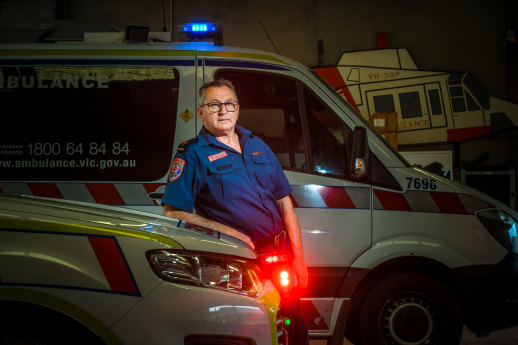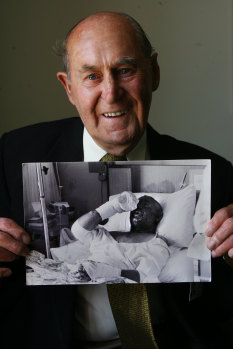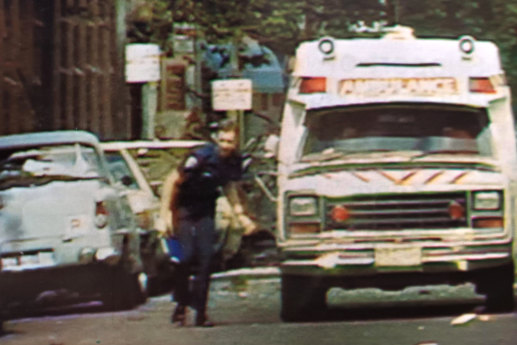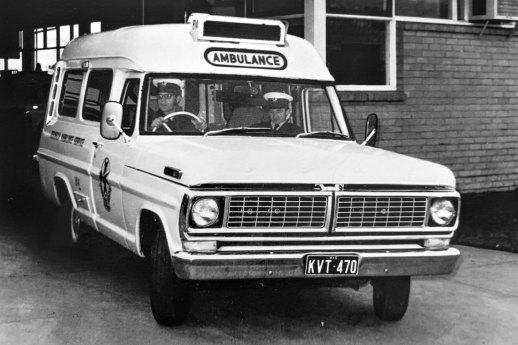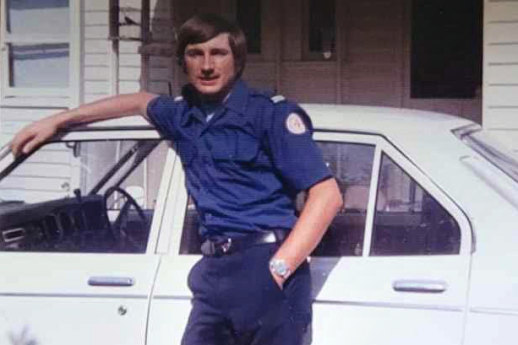‘I won’t miss the trauma’: Paramedic to retire after 49 years of saving lives

The 17-year-old girl, suffering from catastrophic injuries, was trapped in a wrecked car.
Ambulance officer Lance Simmons held her hand as she died. “The last thing she said was, ‘I wish my mum was here,’” he said.
Over and out: Veteran paramedic Lance Simmons will retire on Friday.Credit:Justin McManus
She had been on a joyride when the car, a Porsche, ran off the road and hit a tree. The driver, a 21-year-old man who had been drinking, escaped from the wreck uninjured.
That happened in Berwick, south-east Melbourne, in the early 1980s, but sadly, attending car crashes has been a constant for Simmons, who will retire on Friday after 49 years as an ambulance paramedic.
Ranald Webster in 2008 with a picture of himself recovering from Ash Wednesday burns.Credit:Craig Sillitoe
But since starting his career in 1973 at the Peninsula ambulance station in Frankston, Simmons, 71, has got on with the job, despite often-horrific scenes.
They include attending to the six police officers shot and wounded by burglar Pavel “Mad Max” Marinof in 1985, and the Queen Street massacre in 1987.
The day that sticks most in Simmons’ mind is February 16, 1983, during the Ash Wednesday bushfires, when he and his work partner risked their lives to drive into the still-burning town of Cockatoo, 50 kilometres east of Melbourne. A fire truck accompanied them in case the ambulance caught alight.
At the town’s fire station, the paramedics picked up two badly burned patients including CFA volunteer Ranald Webster, who had swollen and blackened skin and was not expected to live.
But Webster did survive and for years served as a volunteer counsellor to burns patients. Webster thanked Simmons for saving his life 20 years later when the pair reunited.
Simmons, whose wife is also a paramedic, said that in 1983, emergency workers coped with trauma by drinking with mates at the pub and repressing their emotions.
An ambulance at the scene of the Russell Street bombing in Melbourne in 1986.
After Ash Wednesday, Simmons lobbied politicians to provide counselling for ambulance officers. It came through three years later, helped by the ambulance union, after the Russell Street bombing.
Simmons remembers the scene of the bombing as “total chaos with people running around everywhere and people lying around with shrapnel wounds”.
He had just parked tens of metres away when a car’s petrol tank exploded.
A lot has changed in ambulance practice since then.
Lance Simmons in 1973, in the passenger seat on his first week on the job at Peninsula ambulance station in Frankston.
When Simmons started in 1973, officers drove Ford trucks, some of which were so rusty, the paramedics could see through the floor.
The only pain relief drug for patients was an anaesthetic called trilene. Today’s trove includes morphine and fentanyl.
To revive cardiac arrest cases in the 1970s, manual CPR was used, with none of today’s heart-starting defibrillators or portable ECG machines.
An Omeo man Simmons resuscitated after a cardiac arrest seven years ago rings him every Christmas.
Ambulance officer Lance Simmons circa 1979.
“He says, ‘Thanks for giving me another year of life.’ It’s quite emotional. I say I’m glad that his children get to see him every Christmas.”
Retired ambulance officer Peter Frayne said when working on jobs including drug overdoses, shootings and sieges in the Springvale area in the late 1990s and early 2000s, Simmons was “ultra-cool in a crisis”.
Frayne said Simmons, who was awarded the Ambulance Service Medal in the 2020 Australia Day Honours list, was kind, empathetic and clinically outstanding.
“There are hundreds of people walking around today because he has saved their lives,” Frayne said.
Ambulance Victoria chief executive Tony Walker said the service won’t be the same without Simmons.
“Forty-nine years is an impressive innings, and we thank Lance for his dedicated service over that time,” Walker said.
Simmons, who lives in Bairnsdale in East Gippsland and has three children and five grandchildren, said he was retiring because his youngest, 18, had finished VCE, and it felt like the right time to leave.
“It’s a very taxing job. I missed a lot of social things because of the job,” he said.
He intends to play golf, fish and travel. He will miss the camaraderie with workmates but not the shift work.
“I won’t miss the trauma and grief that we see every day.”
The Morning Edition newsletter is our guide to the day’s most important and interesting stories, analysis and insights. Sign up here.
Most Viewed in National
From our partners
Source: Read Full Article
